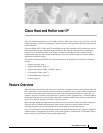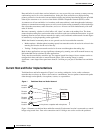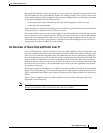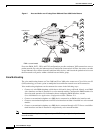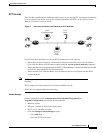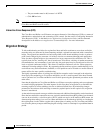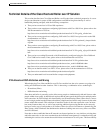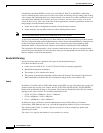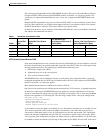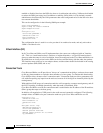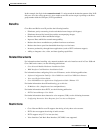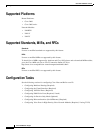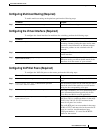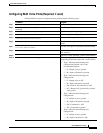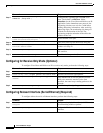
Cisco Hoot and Holler over IP
Feature Overview
6
Cisco IOS Release 12.1(5)T
–
The port number must be 80, because it is HTTP.
–
Click OK and exit.
Note In the Content Manager, be sure to specify the multicast IP address and RTP port for the
Cisco Hoot and Holler over IP session.
Interactive Voice Response (IVR)
The Cisco Hoot and Holler over IP feature can support Interactive Voice Response (IVR) as a means of
authentication, authorization, and accounting (AAA) control. See the section “Configuring Interactive
Voice Response (IVR) ” in the Multiservice Applications Configuration Guide and the command
descriptions in the Multiservice Applications Command Reference for more information.
Migration Strategy
To aid troubleshooting and allow for regionalized hoot and holler conferences, most hoot and holler
networks today are structured by interconnecting multiple, regional hoot networks with a centralized
bridge. The regional hoot networks are built using either carrier-based multidrop circuits or point-to-
point circuits bridged by the customer. All of these circuits are connected through patch panels that
allow for these regional bridges to be connected for a larger corporate-wide conference call. This is
typically done for the "morning call" that is broadcast to all locations, advising of market movements,
recommendations, and commentary. Later in the day, the patch panel may be reconfigured to allow for
local or regional conference bridges. This allows for multiple conference calls for various purposes,
without provisioning multiple circuits. By segmenting the network into regions, troubleshooting is also
easier because any audio disturbance, feedback, or level problems can be isolated to a smaller subset of
remote offices for more specific troubleshooting.
The highly segmented nature of existing hoot and holler networks can be leveraged in the migration
from legacy hoot technology to Cisco Hoot and Holler over IP. A small segment of the hoot network
can be converted to Cisco Hoot and Holler over IP while preserving the operational procedures at the
main office.
Note that the migration to Cisco Hoot and Holler over IP does not require replacing end-user equipment
or central bridging equipment. The main impetus for this first phase of migration is to eliminate the
recurring expense of carrier multidrop circuits or dedicated leased lines. By minimizing changes
presented to the end user while realizing an attractive payback period on the capital costs, migration
success is maximized.
As the entire hoot network converges with the data network, additional functionality can be introduced.
Since the hoot and holler connections are now carried in standard multicast RTP packets, hoot channels
can now be received by a soft client such as IP/TV, which can receive an IP multicast RTP stream. An
alternate migration strategy is to use Cisco Hoot and Holler over IP technology initially as a backup for
the existing hoot circuits within a region with a phased plan of cutting over to Cisco Hoot and Holler
over IP as the primary transport while keeping the existing circuits as a backup for a predefined burn-in
period.



